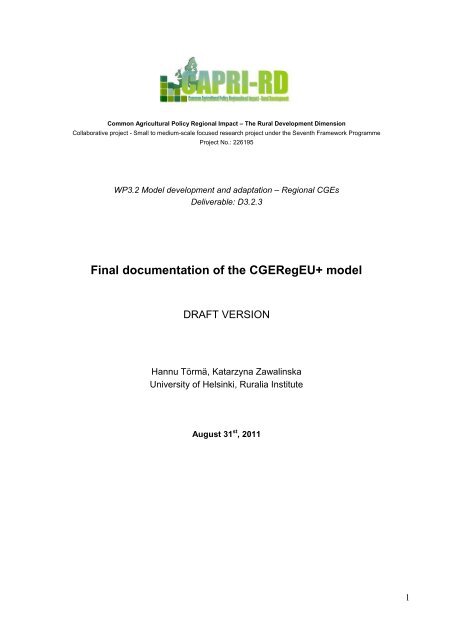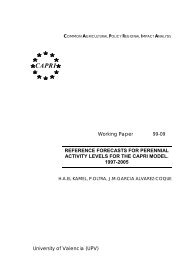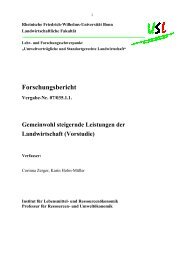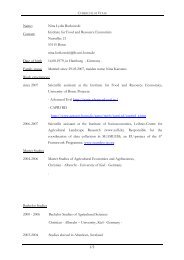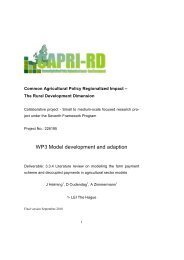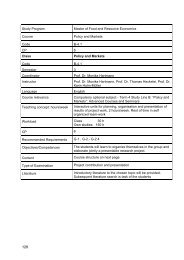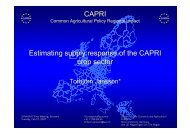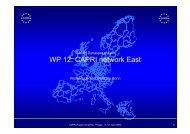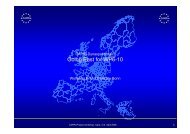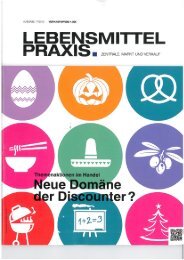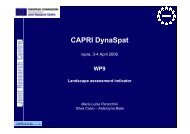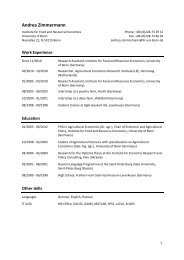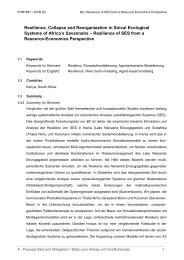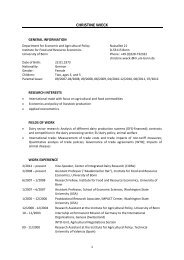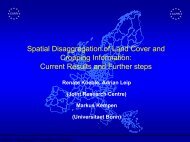Final documentation of the CGERegEU+ model
Final documentation of the CGERegEU+ model
Final documentation of the CGERegEU+ model
You also want an ePaper? Increase the reach of your titles
YUMPU automatically turns print PDFs into web optimized ePapers that Google loves.
Common Agricultural Policy Regional Impact – The Rural Development Dimension<br />
Collaborative project - Small to medium-scale focused research project under <strong>the</strong> Seventh Framework Programme<br />
Project No.: 226195<br />
WP3.2 Model development and adaptation – Regional CGEs<br />
Deliverable: D3.2.3<br />
<strong>Final</strong> <strong>documentation</strong> <strong>of</strong> <strong>the</strong> <strong>CGERegEU+</strong> <strong>model</strong><br />
DRAFT VERSION<br />
Hannu Törmä, Katarzyna Zawalinska<br />
University <strong>of</strong> Helsinki, Ruralia Institute<br />
August 31 st , 2011<br />
1
Contents<br />
1 Introduction .................................................................................................................................. 3<br />
2 Additions to <strong>the</strong> base <strong>model</strong> ......................................................................................................... 3<br />
2.1 Dixon-Parmenter-Sutton-Vincent (DPSV) investment rule .................................................. 3<br />
2.2 Balance <strong>of</strong> payment equations (EU co-financing <strong>of</strong> RD measures) ...................................... 6<br />
3 Closures ........................................................................................................................................ 8<br />
3.1 Automatic (technical) closure in Tablo ................................................................................. 8<br />
3.2 Changes to <strong>the</strong> automatic closure ........................................................................................ 10<br />
3.2.1 Swaps proposed in <strong>the</strong> closure ..................................................................................... 12<br />
4 Modelling <strong>of</strong> RD measures ........................................................................................................ 12<br />
4.1 Variables and shocks ........................................................................................................... 13<br />
4.1.1 Modelling investments in human capital ..................................................................... 13<br />
4.1.2 Subsidies for investments in physical capital .............................................................. 14<br />
4.1.3 Direct income transfers ................................................................................................ 15<br />
4.1.4 Land subsidies .............................................................................................................. 15<br />
4.1.5 Subsidies for non-agricultural services in rural areas .................................................. 16<br />
4.2 Parameterization <strong>of</strong> <strong>the</strong> shocks ............................................................................................ 16<br />
4.2.1 Shocks for investment in human capital ...................................................................... 16<br />
4.2.2 Shocks for investments in physical capital .................................................................. 16<br />
4.2.3 Shocks for direct income transfers ............................................................................... 17<br />
4.2.4 Shocks for land subsidies ............................................................................................. 17<br />
4.2.5 Shocks for non-agricultural services in rural areas ...................................................... 17<br />
5 Running <strong>the</strong> base <strong>model</strong> in GEMPACK .................................................................................... 18<br />
5.1 GEMPACK sub-programs .................................................................................................. 18<br />
5.2 Simulation setup in RunGEM ............................................................................................. 19<br />
6 Conclusions and summary ......................................................................................................... 21<br />
7 List <strong>of</strong> measures under 2007-2013 RDPs .................................................................................. 22<br />
8 Bibliography............................................................................................................................... 23<br />
2
1 Introduction<br />
This paper documents how to use <strong>the</strong> CGERegEU <strong>model</strong> to simulate <strong>the</strong> Pillar II measures at <strong>the</strong><br />
NUTS 2 level for EU27+ countries. It starts with <strong>the</strong> update on <strong>the</strong> latest <strong>model</strong>‟s development after<br />
<strong>the</strong> deliverable D.3.2.2. The most recent additions concern two aspects: improving <strong>the</strong><br />
characteristics <strong>of</strong> investments (i.e. introducing quasi dynamics in <strong>the</strong> comparative static <strong>model</strong>) and<br />
featuring <strong>the</strong> external co-financing from <strong>the</strong> EU budget for <strong>the</strong> Pillar II measures (i.e. adding<br />
balance <strong>of</strong> payment equations). Fur<strong>the</strong>r, <strong>the</strong> paper explains: <strong>the</strong> possible choices for <strong>the</strong> <strong>model</strong>‟s<br />
closures – depending on <strong>the</strong> policy focus (e.g. short run vs. long run, etc.). It also explains <strong>the</strong><br />
simulation design <strong>of</strong> <strong>the</strong> RD measures in terms <strong>of</strong> <strong>the</strong> variables and shocks implemented. Then it<br />
includes a short manual on how to use <strong>the</strong> GEMPACK s<strong>of</strong>tware in order to actually run <strong>the</strong> <strong>model</strong><br />
and produce robust results on <strong>the</strong> regional impact <strong>of</strong> Pillar II measures. The paper ends with<br />
summary and conclusions as well as with <strong>model</strong> coding and electronic version <strong>of</strong> all essential files<br />
needed to run <strong>the</strong> <strong>model</strong>.<br />
2 Additions to <strong>the</strong> base <strong>model</strong><br />
In D3.2.2 we added four new features into <strong>the</strong> base <strong>model</strong>. They are: <strong>the</strong> land factor, different real<br />
wage <strong>the</strong>ories, <strong>the</strong> Stone-Geary utility function (instead <strong>of</strong> Cobb-Douglas) and public sector<br />
accounting. Thanks to <strong>the</strong>se additions we have now three primary production factors: labour,<br />
capital, and land. Besides, now we can experiment with different wage <strong>the</strong>ories: sticky wages,<br />
adjusted Phillips curve or Wage curve based real wages. The Cobb-Douglas utility function has<br />
been replaced with <strong>the</strong> Stone-Geary leading to Linear Expenditure System, which is more<br />
sophisticated. Public sector accounting shows <strong>the</strong> tax revenues collected, and transfers given.<br />
Comparing to <strong>the</strong> second deliverable two new features have been added to <strong>the</strong> <strong>model</strong>. First, <strong>the</strong><br />
investment rule allowing investment demands to be industry specific and endogenous, even if <strong>the</strong><br />
<strong>model</strong> is still comparative static in its nature. Second, balance <strong>of</strong> payment equations were<br />
introduced to allow taking into account <strong>the</strong> external EU co-financing <strong>of</strong> <strong>the</strong> Pillar II measures from<br />
<strong>the</strong> EARDF budget.<br />
2.1 Dixon-Parmenter-Sutton-Vincent (DPSV) investment rule<br />
Up till now investments have been exogenous. For our purposes, it is better to use a more advanced<br />
investment rule, which is called DPSV (Dixon, Parmenter, Sutton, and Vincent, 1982, cp. 19).<br />
According to this <strong>the</strong>ory, investments made during a year can affect <strong>the</strong> capital stock <strong>of</strong> <strong>the</strong> same<br />
year. We begin by presenting a conventional investment-capital stock flow mechanism. Small<br />
letters indicate percentage changes.<br />
xcap 1 = xinv 1 + (1 – δ) xcap 0 (all i, r)<br />
xcap 0 and xcap 1 refer to <strong>the</strong> capital stock at <strong>the</strong> beginning and end <strong>of</strong> <strong>the</strong> same year, xinv 1 is<br />
investment or creation <strong>of</strong> new capital goods during <strong>the</strong> year, and δ is <strong>the</strong> rate <strong>of</strong> depreciation, wear<br />
3
and tear <strong>of</strong> <strong>the</strong> capital stock. The new capital goods xinv 1 are assumed to be produced according to<br />
<strong>the</strong> Leontief structure from domestic inputs.<br />
The only things that affect <strong>the</strong> capital stock at <strong>the</strong> end <strong>of</strong> one year are <strong>the</strong> current capital stock,<br />
depreciation and investment. It is thus assumed that <strong>the</strong> effects <strong>of</strong> past investment decisions are<br />
fully incorporated in <strong>the</strong> current capital stock.<br />
The <strong>the</strong>ory do not attempt to explain total investments, only how this investment is allocated across<br />
using industries after a change in economic conditions. It is assumed that <strong>the</strong>re is an existing macro<br />
economic policy that determines <strong>the</strong>ir size.<br />
The current gross rate <strong>of</strong> return on fixed capital in a sector, gret is defined as <strong>the</strong> ratio <strong>of</strong> <strong>the</strong> capital<br />
rent, pcap and <strong>the</strong> cost <strong>of</strong> a unit <strong>of</strong> investment, pinv. Net rate <strong>of</strong> return is received by subtracting <strong>the</strong><br />
rate <strong>of</strong> depreciation <strong>of</strong> capital.<br />
gret = pcap - pinv<br />
nret = gret - δ<br />
(all i,r)<br />
The gross rate <strong>of</strong> return or pr<strong>of</strong>itability will increase (decrease) if <strong>the</strong> capital rent increases<br />
(decreases) more (less) than investment costs. Increasing pr<strong>of</strong>itability implies that <strong>the</strong> firms are<br />
earning more capital income than <strong>the</strong>y pay as investment costs. We fur<strong>the</strong>r assume that capital in a<br />
sector takes one year to install.<br />
Investors are assumed to be cautious in assessing <strong>the</strong> effects <strong>of</strong> expanding <strong>the</strong> capital stock in a<br />
sector. They behave as if <strong>the</strong>y expect that sector‟s rate <strong>of</strong> return schedule in one year‟s time have<br />
<strong>the</strong> following form.<br />
gret 1 = gret 0 - β (xcap 1 - xcap 0 )<br />
(all i,r)<br />
0 and 1 represent <strong>the</strong> situation at <strong>the</strong> beginning and end <strong>of</strong> same year, and β is a positive parameter.<br />
The schedule is in <strong>the</strong> following figure.<br />
4
Figure 1 Expected rate <strong>of</strong> return schedule for a sector (Dixon et al., 1982)<br />
The horizontal axis measures <strong>the</strong> difference between <strong>the</strong> future and current capital stocks, measured<br />
as percentage points. The vertical axis shows <strong>the</strong> expected rate <strong>of</strong> return. If <strong>the</strong> capital stock were<br />
maintained at <strong>the</strong> existing level, <strong>the</strong>n <strong>the</strong> expected rate <strong>of</strong> return would be <strong>the</strong> current rate <strong>of</strong> return,<br />
gret 0 . However, if investment plans were set so that xcap 1 – xcap 0 would reach <strong>the</strong> level A, <strong>the</strong>n<br />
businessmen would behave as if <strong>the</strong>y espected <strong>the</strong> rate <strong>of</strong> return to fall to B.<br />
Now we assume that total investment expenditure, xinv_ir is allocated across industries so as to<br />
equate <strong>the</strong> expected rates <strong>of</strong> return. This means that <strong>the</strong>re exists some rate <strong>of</strong> return ω such that<br />
-β (xcap 1 - xcap 0 ) gret 0 = ω (all i,r)<br />
The gross growth rate <strong>of</strong> capital, ggro in a sector increases (decreases) if <strong>the</strong> gross rate <strong>of</strong> return <strong>of</strong><br />
that sector is larger (smaller) than <strong>the</strong> economy-wide rate <strong>of</strong> return ω. This indicates that<br />
investments grom faster that <strong>the</strong> capital stock within one year.<br />
ggro = xinv – xcap<br />
(all i,r)<br />
After substitutions <strong>of</strong> <strong>the</strong> above equations we get an equation for <strong>the</strong> gross growth rate <strong>of</strong> capital.<br />
ggro = finv + 0.33 (2.0 gret – invslack)<br />
(all i,r)<br />
finv is a shifter to enforce DSPV investment rule, 0.33 is 1/β, 2.0 is <strong>the</strong> ratio <strong>of</strong> gross to net rate <strong>of</strong><br />
return and invslack corresponds to ω, <strong>the</strong> exogenous economy-wide rate <strong>of</strong> return. It is to be<br />
interpreted as a risk related relationship with relatively fast- (slow-) growing industries requiring<br />
premia (accepting discounts) on <strong>the</strong>ir rates <strong>of</strong> return. According to Horridge (2003) attempts to<br />
improve <strong>the</strong> <strong>the</strong>ory by updating <strong>the</strong>se parameter values have been found to occasionally lead to<br />
perversely signed coefficients.<br />
5
Considering <strong>the</strong> conventional investment-capital stock flow mechanism (see above), total<br />
investment expenditure is as follows.<br />
xinv_ir = ∑ i,r pinv xinv<br />
(all i,r)<br />
The DPSV rule relates for most sectors <strong>the</strong> investment <strong>of</strong> each sector to pr<strong>of</strong>itability in that sector.<br />
The effect is that sectors which become more pr<strong>of</strong>itable attract more investment. In some sectors,<br />
like in those where investment is determined by government policy, this rule might be<br />
inappropriate. In <strong>the</strong>se sectors investments are not mainly driven by current pr<strong>of</strong>its, like in<br />
education, administration etc. For this kind <strong>of</strong> sectors, it is better to let investment follow aggregate<br />
investment or national/regional trend (Horridge, 2003).<br />
2.2 Balance <strong>of</strong> payment equations (EU co-financing <strong>of</strong> RD measures)<br />
Since Pillar II measures are at least partly financed by EU (usually 75% to 80%) we need to take it<br />
into account in our <strong>model</strong> because <strong>the</strong> outcomes <strong>of</strong> <strong>the</strong> policy differ depending on <strong>the</strong> source <strong>of</strong> its<br />
financing (domestic vs. foreign financing). If <strong>the</strong> policy is fully financed domestically, <strong>the</strong> spending<br />
has to be covered through savings/earnings obtained elsewhere in <strong>the</strong> domestic economy (e.g. from<br />
increased government revenues from higher taxes). It is different if <strong>the</strong> financing comes from<br />
outside <strong>of</strong> <strong>the</strong> economy, from abroad (e.g. EU budget 1 ) <strong>the</strong>n it affects <strong>the</strong> country‟s position vis-avis<br />
<strong>the</strong> rest <strong>of</strong> <strong>the</strong> world. Hence it affects <strong>the</strong> Balance <strong>of</strong> payments (BOP) accounts, which is a<br />
record <strong>of</strong> all monetary transactions between a country and <strong>the</strong> rest <strong>of</strong> <strong>the</strong> world.<br />
In <strong>the</strong> long run, all components <strong>of</strong> <strong>the</strong> BOP accounts must sum to zero with no overall surplus or<br />
deficits because all debts have to be paid. Thus, <strong>the</strong> current account on one side and <strong>the</strong> capital and<br />
financial account on <strong>the</strong> o<strong>the</strong>r should balance each o<strong>the</strong>r out. When an economy, however, has<br />
positive capital and financial accounts (a net financial inflow), <strong>the</strong> country's debits are more than its<br />
credits (due to an increase in liabilities to o<strong>the</strong>r economies or a reduction <strong>of</strong> claims in o<strong>the</strong>r<br />
countries). This is usually in parallel with a current account (trade) deficit; an inflow <strong>of</strong> money<br />
means that <strong>the</strong> return on an investment is a debit on <strong>the</strong> current account. Thus, <strong>the</strong> economy is using<br />
world savings to meet its local investment and consumption demands. It is a net debtor to <strong>the</strong> rest <strong>of</strong><br />
<strong>the</strong> world. This is <strong>the</strong> case <strong>of</strong> co-financing <strong>of</strong> RD measures, where <strong>the</strong> contributions from <strong>the</strong><br />
European Agricultural Fund for Rural Development (EAFRD) are counted as capital inflows. That<br />
is why we allow in <strong>the</strong> <strong>model</strong> <strong>the</strong> balance <strong>of</strong> trade (BOT) moving towards <strong>the</strong> deficit by <strong>the</strong> value <strong>of</strong><br />
<strong>the</strong> EAFRD contributions to Pillar II measures, in order to counterbalance BOP.<br />
The following variables and equations were added to <strong>the</strong> <strong>model</strong> in order to take account <strong>of</strong> <strong>the</strong> BOP<br />
balancing:<br />
1 Of course it has not to be forgotten that countries pay contributions to <strong>the</strong> EU budget anyway, and some are net<br />
creditors while o<strong>the</strong>r are net debtors towards <strong>the</strong> CAP policy in general.<br />
6
Balance <strong>of</strong> trade is <strong>the</strong> difference between <strong>the</strong> value <strong>of</strong> total exports and imports to/from <strong>the</strong> rest <strong>of</strong><br />
<strong>the</strong> world (ROW).<br />
BOT = ∑ r VROWEXPtot - ∑ r VROWIMPtot<br />
The ratio <strong>of</strong> <strong>the</strong> BOT to <strong>the</strong> value <strong>of</strong> <strong>the</strong> expenditure side GDP is <strong>of</strong> <strong>the</strong> following form.<br />
R_BOT_GDP = BOT / ∑ r GDPEXP<br />
The percentage change in <strong>the</strong> BOT, d_bot is defined as follows.<br />
100 * d_bot = ∑ r VROWEXPtot* (xrowexp_cr + prowexp_cr)<br />
- ∑ r VROWIMPtot* (xrowimp_cr + prowimp_cr)<br />
xrowexp_cr and xrowimp_cr are percentage changes <strong>of</strong> national exports, and prowexp_cr and<br />
prowimp_cr are <strong>the</strong> corresponding prices. The variables on <strong>the</strong> paren<strong>the</strong>s are endogenous, so d_bot<br />
will change according to <strong>the</strong>ir adjustment.<br />
The percentage change in <strong>the</strong> BOT/GDP ratio depends on:<br />
(100 / R_BOT_GDP) * d_bot_gdp = (100 / BOT) * d_bot – wgdpexp_r<br />
Here wgdpexp_r is national nominal expenditure side GDP.<br />
It is important to mention that in case <strong>of</strong> inflow <strong>of</strong> euros to <strong>the</strong> economies which have o<strong>the</strong>r than<br />
euro currencies (e.g. zloty in Poland, koruna in Czech Republic, etc.) <strong>the</strong> inflow makes a pressure<br />
on appreciation <strong>of</strong> <strong>the</strong> domestic currencies (prowimp), since euro have to be exchanged into<br />
national currency which increases <strong>the</strong> demand for it.<br />
Taking into account external co-financing from EARDF requires establishing <strong>the</strong> following shock<br />
statement in <strong>the</strong> command file:<br />
Shock d_bot = - x;<br />
where x equals to amount <strong>of</strong> co-financing from EARDF in mln <strong>of</strong> national currency. As explained<br />
before, <strong>the</strong> shock is negative, because percentage change <strong>of</strong> <strong>the</strong> balance <strong>of</strong> trade (d_bot) has to be<br />
put into deficit in order to counterbalance <strong>the</strong> financial inflows.<br />
7
3 Closures<br />
One important feature <strong>of</strong> <strong>the</strong> base <strong>model</strong> implemented in <strong>the</strong> GEMPACK s<strong>of</strong>tware is its ability to<br />
set up closures specific for each policy simulations which can be changed (adjusted) in order to<br />
reflect <strong>the</strong> reality in <strong>the</strong> <strong>model</strong> well as possible. In o<strong>the</strong>r words, <strong>the</strong> choice <strong>of</strong> closure in CGE <strong>model</strong><br />
determines <strong>the</strong> choice <strong>of</strong> macroeconomic <strong>the</strong>ory used in simulation and also decides about <strong>the</strong><br />
causalities leading to <strong>the</strong> particular results (Taylor i von Arnim, 2007]. Technically <strong>the</strong> closure <strong>of</strong><br />
<strong>the</strong> <strong>model</strong> for a particular simulation specified which variables are exogenous (that is, <strong>the</strong>ir values<br />
are given as shocks are unchanged in levels) and which variables are endogenous (that is, <strong>the</strong><br />
variable calculated when <strong>the</strong> <strong>model</strong> is solved).<br />
3.1 Automatic (technical) closure in Tablo<br />
Technically, <strong>the</strong> number <strong>of</strong> endogenous variables in a CGE <strong>model</strong> must equal <strong>the</strong> number <strong>of</strong><br />
equations. For complex <strong>model</strong>s with thousands <strong>of</strong> equations and variables having various<br />
dimensions (multi regions, sectors, factors, etc.) it is a very demanding task to find a sensible<br />
closure, which satisfies this accounting restriction. That is why GEMPACK provides a technical<br />
check up and <strong>of</strong>fers a list <strong>of</strong> all unmatched (without equations) variables which are most probably<br />
exogenous (<strong>the</strong> rest is assumed endogenous) 2 . The automatic closure for <strong>CGERegEU+</strong> is provided<br />
as follows.<br />
Table 1 Automatic closure for <strong>CGERegEU+</strong><br />
! Automatic closure generated by TABmate Tools...Closure command<br />
Variable / Dimension<br />
Exogenous acap ; ! IND*REG Capital-augmenting technical change<br />
Exogenous alab ; ! IND*REG Labor-augmenting technical change<br />
Exogenous aland ; ! IND*REG Land-augmenting technical change<br />
Exogenous aprim ; ! IND*REG Primary-factor-augmenting tech change<br />
Exogenous atot ; ! IND*REG All-input-augmenting technical change<br />
Exogenous<br />
Exogenous<br />
ahou_s ; ! COM*REG Taste change, househ. imp/dom composite<br />
fhou ; ! REG Reg. aver. propen. to cons. from disp income<br />
Exogenous delCAPTAXRATE ; ! IND*REG Change, capital tax rate<br />
Exogenous delHOUTAXRATE ; ! REG Tax rate, Arm and ROF goods to hou<br />
Exogenous delLABTAXRATE ; ! IND*REG Change, labour tax rate<br />
Exogenous delLANDTAXRATE ; ! IND*REG Change, land tax rate<br />
Exogenous delPRDTAXRATE ; ! IND*REG Change, prod tax rate<br />
Exogenous thouloc ; ! REG Local income tax rate<br />
Exogenous thoustate ; ! REG National income tax rate<br />
Exogenous fgov ; ! COM*GVT*REG Gov. demand shift variable<br />
Exogenous fgov_c ; ! GVT*REG Gov. demand shift variable<br />
Exogenous fgov_cgr ; ! 1 Gov. demand shift variable<br />
Exogenous fgov_cr ; ! GVT Gov. demand shift variable<br />
Exogenous fhou_r ; ! 1 Economy-wide shift on regional APCs<br />
Exogenous finv1 ; ! IND*REG Investment shift variable<br />
Exogenous flab ; ! IND*REG Real wage shifter<br />
2 Technically, authomatic closure is available from TABMATE in Tools/Tablo make code/Closure.<br />
8
Exogenous flab_i ; ! REG Real wage shifter<br />
Exogenous flab_ir ; ! 1 Real wage shifter<br />
Exogenous flab_r ; ! IND Real wage shifter<br />
Exogenous fstatehou ; ! REG Shifter-transf. from nat. gov to reg. hou.<br />
Exogenous fstateloc ; ! REG Shifter: transfers from nat. to reg. gov<br />
Exogenous fstateloc_r ; ! 1 Shifter: transfers from nat. to reg. gov<br />
Exogenous fxserr ; ! COM*REG Xserr shift variable<br />
Exogenous invslack ; ! 1 Invest. slack for exogenizing nat. invest<br />
Exogenous nhou ; ! REG Number <strong>of</strong> households<br />
Exogenous prowexp ; ! COM Price, exports to ROW, National currency<br />
Exogenous prowimp ; ! 1 Price <strong>of</strong> imports, National currency<br />
Exogenous xcap ; ! IND*REG Quantity <strong>of</strong> capital demanded<br />
Exogenous xhoutot ; ! REG Real Spending by households<br />
Exogenous xir<strong>of</strong> ; ! ROF*REG ROF goods used by investment<br />
Exogenous xirow ; ! REG ROW goods for investment<br />
Exogenous xland ; ! IND*REG Quantity <strong>of</strong> land (resource) demanded<br />
Rest endogenous; ! end <strong>of</strong> TABmate automatic closure<br />
The first block <strong>of</strong> <strong>the</strong> exogenous variables (Table1) covers all technical change variables which are<br />
usually exogenous as in <strong>CGERegEU+</strong> (unless <strong>the</strong> <strong>model</strong> has built in <strong>the</strong> endogenous growth <strong>the</strong>ory<br />
in it). There are several input-augmenting technical change variables for individual or grouped<br />
inputs, i.e. labor-augmenting technical change (alab), capital-augmenting technical change (acap),<br />
land-augmenting technical change (aland), and also combined input technical changes, i.e.primaryfactor-augmenting<br />
technical change (aprim) and all-input-augmenting technical change (atot). In<br />
case <strong>of</strong> all technical change variable, <strong>the</strong> negative shock means that <strong>the</strong> technology improved in<br />
terms <strong>of</strong> <strong>the</strong> particular input, so less <strong>of</strong> <strong>the</strong> input is needed to obtain <strong>the</strong> same amount <strong>of</strong> output than<br />
before (<strong>the</strong> whole isoquant shifts).<br />
Apart from technical variables also <strong>the</strong> taste variable is included (ahou_s) and <strong>the</strong> propensity to<br />
consume which both are naturally set up outside <strong>of</strong> <strong>the</strong> <strong>model</strong>, at least in <strong>the</strong> short run closure. The<br />
next block <strong>of</strong> exogenous variables consists <strong>of</strong> <strong>the</strong> tax rates both indirect (on labour, land, capital,<br />
goods and production) and direct (local and national income tax). Since those variables are policy<br />
tools <strong>the</strong>y naturally come as exogenous in <strong>the</strong> <strong>model</strong>.<br />
Ano<strong>the</strong>r exogenous block <strong>of</strong> variables covers a broad range <strong>of</strong> shifters. Shift variables are ones that<br />
are originally exogenous and <strong>the</strong>y are used in order to switch on or <strong>of</strong>f certain equations in order to<br />
choose which variant <strong>of</strong> <strong>the</strong> <strong>the</strong>ory we want to follow. For example in <strong>the</strong> labour market block <strong>the</strong>re<br />
is one real wage equation per wage <strong>the</strong>ory, with labour shifters. Three wage <strong>the</strong>ories <strong>of</strong>fer a choice<br />
between sticky wages in <strong>the</strong> short run vs fully adjustable nominal wages along wage curve (see <strong>the</strong><br />
equations explained in D3.2.2). There are real wage shifters (flab shifters) in all real wage <strong>the</strong>ories<br />
with different sectoral and regional dimensions. Consider <strong>the</strong> first <strong>the</strong>ory. When <strong>the</strong> shifters are<br />
exogenous <strong>the</strong>ir value will be zero. In this case nominal wage follow inflation, so real wage is<br />
sticky. The assumption is <strong>the</strong> third <strong>the</strong>ory where <strong>the</strong> change <strong>of</strong> <strong>the</strong> unemployment rate and real<br />
wage are determined jointly. In similar fashion work o<strong>the</strong>r shifters - in equations for distribution <strong>of</strong><br />
government demand, for transfers from government to households, for exogenising national<br />
investment, etc.<br />
9
Fur<strong>the</strong>r, <strong>the</strong> number <strong>of</strong> households is exogenous as well as reference prices (in national currency) -<br />
prowimp - price <strong>of</strong> imports (numeraire), and prowexp – price <strong>of</strong> exports. Their exogeneity comes<br />
from <strong>the</strong> small open economy assumption. Last but not least, <strong>the</strong> block <strong>of</strong> certain quantity variables<br />
is exogenous. They include: quantity <strong>of</strong> capital and land demanded, real spending by households<br />
(from LES), goods used by investment including imported goods to it.<br />
3.2 Changes to <strong>the</strong> automatic closure<br />
There is no unique or proper closure, on <strong>the</strong> o<strong>the</strong>r hand closure needs to be justifiable. Basically<br />
<strong>the</strong>re are three reasons for which we alter <strong>the</strong> automatic closure: 1) to take account <strong>of</strong> <strong>the</strong> time<br />
horizon <strong>of</strong> <strong>the</strong> simulations (short vs. long run closure), 2) to take account <strong>of</strong> <strong>the</strong> macroeconomic<br />
features <strong>of</strong> analysed economies (e.g. small open economy vs. big open economy), 3) to allow<br />
particular policy simulations.<br />
The typical short run closure in a comparative static <strong>model</strong> assumes that employment is endogenous<br />
while capital and land are exogenous. Wages in short run are usually assumed to be sticky - little<br />
responsiveness due to wage contracts, labour union negotiations, etc.. Rate <strong>of</strong> return on capital is<br />
endogenous. Trade balance is endogenous but <strong>the</strong> remaining composites <strong>of</strong> GDP expenditure side<br />
(private and public consumption) are exogenous (Figure 1).<br />
Figure 1 Typical causation in short-run closure in a comparative-static <strong>model</strong><br />
Source: OraniG course materials by CoPS, Monash University Melbourne Australia<br />
10
On <strong>the</strong> contrary <strong>the</strong> long run closure assumes that employment is exogenous (does not depend on<br />
policy but demographic determinants) and determines real wage. Capital stock is endogenous and<br />
depends on rate <strong>of</strong> return on capital. If DPSV (or o<strong>the</strong>r endogenization <strong>of</strong> investment rule) is<br />
included, <strong>the</strong>n sectoral investment follows capital. Land can be sometimes endogenous in <strong>the</strong> long<br />
run as well (if <strong>the</strong>re are some reserves in some types <strong>of</strong> land and if land supply is responsive to<br />
policy measures) or exogenous as usually it is a case. Trade balance is exogenous in long run while<br />
o<strong>the</strong>r elements <strong>of</strong> national absorption are endogenous (public and private consumption and<br />
investments).<br />
Figure 2 Typical causation in <strong>the</strong> long-run closure in a comparative-static <strong>model</strong><br />
Source: OraniG course materials by CoPS, Monash University Melbourne Australia<br />
Typically, macro-environment in <strong>the</strong> closure refers to macroeconomic determinants (<strong>the</strong>ories) for<br />
particular economies. It includes also relations <strong>of</strong> <strong>the</strong> economy vis-a-vis <strong>the</strong> rest <strong>of</strong> <strong>the</strong> world. If <strong>the</strong><br />
economy is small it cannot affect <strong>the</strong> rest <strong>of</strong> <strong>the</strong> world prices, so price <strong>of</strong> exports and also price <strong>of</strong><br />
imports are exogenous. In <strong>the</strong> short run a country can run on deficit on <strong>the</strong> trade account which<br />
represents national dissaving, so balance <strong>of</strong> trade can be endogenous. However, no country can run<br />
<strong>the</strong> trade deficit constantly, so in <strong>the</strong> long run it is natural to fix <strong>the</strong> balance <strong>of</strong> trade so it becomes<br />
exogenous. Besides, if <strong>the</strong> policy is financed from abroad, <strong>the</strong> trade balance is affected so it is<br />
exogenised to be shocked by <strong>the</strong> amount <strong>of</strong> <strong>the</strong> external financing. Macro-environment can also<br />
specify which wage <strong>the</strong>ory is used (sticky wages or wage curve, etc.) and o<strong>the</strong>r economic <strong>the</strong>ories.<br />
11
Simulations can specifically require some exogenisation <strong>of</strong> certain variables to shock <strong>the</strong>m or<br />
endogenisation to see <strong>the</strong> effect on <strong>the</strong>m. For example in case <strong>of</strong> direct transfers to households (as in<br />
case <strong>of</strong> early retirement scheme) <strong>the</strong>y are initially endogenous but since we know <strong>the</strong> amounts<br />
transferred to <strong>the</strong>m we exogenise <strong>the</strong>m so to shock <strong>the</strong>m and <strong>the</strong>n see <strong>the</strong> policy effects.<br />
3.2.1 Swaps proposed in <strong>the</strong> closure<br />
All <strong>the</strong> changes to <strong>the</strong> automatic closure are done by swapping <strong>the</strong> initially exogenous variables<br />
with <strong>the</strong> presently endogenous ones. The following swaps are proposed for our simulations and as<br />
such are <strong>the</strong> part <strong>of</strong> <strong>the</strong> command file (below <strong>the</strong> automatic closure):<br />
1) Time horizon swaps<br />
! Long-run factor market closure<br />
swap xcap = fgret; ! Capital stock determined endogenously<br />
swap finv1 = ggro; ! Investment follows xcap<br />
swap flab_ir = xlab_ir; ! Total labour is exog. for demographic reasons<br />
2) Macro-environment swaps<br />
swap fgov = xgov; ! Government budget is fixed so <strong>the</strong> policy affects<br />
only <strong>the</strong> private sector<br />
swap d_bot = prowimp; !Foreign trade is in balance<br />
3) Policy swaps<br />
swap fhou = whou; !to enable direct income transfer as in <strong>the</strong> case <strong>of</strong><br />
early retirement<br />
4 Modelling <strong>of</strong> RD measures<br />
There are more than 40 measures to be <strong>model</strong>led within RDP 2000-2006 and 2007-2013. In order to<br />
handle <strong>the</strong>m for all EU27+ NUTS2 regions we need to group <strong>the</strong>m. In D.3.2.1 we proposed 5 major<br />
categories <strong>of</strong> policy instruments subdivided into altoge<strong>the</strong>r 10 fairly homogeneous groups <strong>of</strong><br />
measures which can be simulated toge<strong>the</strong>r. Instruments in group 1 are subsidies for investments in<br />
human capital so <strong>the</strong>y increase productivity (not only labor productivity but also indirectly o<strong>the</strong>r<br />
factors‟ productivity) in ei<strong>the</strong>r agricultural or o<strong>the</strong>r services sector; instruments in group 2 are<br />
subsidies for investments in physical capital in such sectors as construction, agriculture, forestry,<br />
and food processing; group 3 ga<strong>the</strong>rs measures implemented in form <strong>of</strong> direct income transfers for<br />
individual farmers or groups <strong>of</strong> farmers (such as early retirement or young farmers‟ support under<br />
2000-2006 scheme); group 4 can be called compensatory aids and is granted in form <strong>of</strong> land<br />
subsidies ei<strong>the</strong>r in agricultural or forestry sector; group 5 combines measures aiming at increasing<br />
non-agricultural activities and outputs in rural areas, which are mainly materializing in a services<br />
12
sector (e.g. tourism, trade, transport, etc.). So <strong>the</strong>y are basically subsidies for non-agricultural<br />
services in rural areas.<br />
4.1 Variables and shocks<br />
For each group <strong>of</strong> policy measures <strong>the</strong>re is a different policy design. Please also refer to Table 3 in<br />
deliverable D.3.2.1.<br />
4.1.1 Modelling investments in human capital<br />
Among investments in human capital we distinguish two subgroups <strong>of</strong> measures, those which<br />
directly aim to improve human capital <strong>of</strong> farmers (or <strong>of</strong> agricultural sector) and those which aim to<br />
increase human capital (outside <strong>of</strong> agriculture) in rural areas.<br />
In <strong>the</strong> first group, improving human capital in agricultural sector, we would <strong>model</strong> <strong>the</strong> following<br />
measures: 111, 114, 115, 132, 133, 142, 143 and 331 (see list <strong>of</strong> measures in Annex 7.5). They are<br />
mostly related to improving labour productivity <strong>of</strong> farmers but also o<strong>the</strong>r types <strong>of</strong> productivity<br />
because farmers get more training and information also on how to use o<strong>the</strong>r inputs more effectively<br />
and efficiently.<br />
1) The proposed shocks are to total factor productivity in agricultural sector: atot (IND*REG):<br />
all-input-augmenting technical change, where IND would be “AGR” and REG all regions<br />
which have those measures. The value <strong>of</strong> <strong>the</strong> shock would be a percentage change between<br />
<strong>the</strong> TFP in initial situation and TFP after <strong>the</strong> value <strong>of</strong> all inputs toge<strong>the</strong>r are subsidied by <strong>the</strong><br />
amount <strong>of</strong> <strong>the</strong> measure. This means that thanks to those measures <strong>the</strong> TFP increased because<br />
<strong>the</strong> inputs can be saved by <strong>the</strong> amount <strong>of</strong> subsidy. So:<br />
,<br />
where Q(i,r) is <strong>the</strong> initial value <strong>of</strong> production in agricultural sector in certain region<br />
and I (i,r) is <strong>the</strong> initial value <strong>of</strong> all inputs used in agriculture in <strong>the</strong> region. Then, after<br />
<strong>the</strong> RDP measures are implemented to improve productivity <strong>of</strong> human capital in<br />
agricultural sector <strong>the</strong> total factor productivity it calculated as:<br />
.<br />
The value <strong>of</strong> <strong>the</strong> shock is <strong>the</strong> percentage change difference between <strong>the</strong> two, so:<br />
*100<br />
Example: If <strong>the</strong> value <strong>of</strong> agricultural production in certain region is 100 million and <strong>the</strong> value <strong>of</strong><br />
total factor inputs to agriculture in this region is 80 million, <strong>the</strong>n TFP1 =100/80= 1.25. Then, if <strong>the</strong><br />
value <strong>of</strong> all measures related to human capital for agriculture in this region is let‟s say 20 million<br />
<strong>the</strong>n TFP2=100/(80-20)= 1.67. Then <strong>the</strong> shock value = (1.25-1.67)/1.67= -0,25. It means that we<br />
increase TFP in agriculture in certain region by 0,25% due to <strong>the</strong> RDP measures devoted to<br />
improving human capital productivity. See <strong>the</strong> next section for appropriate shock notation for <strong>the</strong><br />
command file.<br />
13
2) The second group <strong>of</strong> increasing human capital (outside <strong>of</strong> agriculture) include: 341, 411-<br />
413, 421, 431, 511. They are measures which aim at increasing <strong>the</strong> amount <strong>of</strong> human capital<br />
and non-agricultural economy in rural areas. The difference to <strong>the</strong> first group is that <strong>the</strong><br />
former aimed at increasing productivity <strong>of</strong> human capital, while those measures aim to<br />
increase <strong>the</strong> amount <strong>of</strong> human capital in rural areas by developing non-agricultural<br />
activities. That is why we propose to simulate it as a subsidy to capital 3 in non-agricultural<br />
sectors, and primarily in services. So <strong>the</strong> variable proposed to be shocked now is:<br />
delCAPTAXRATE (IND,REG) - which is a subsidy rate for capital in certain sectors in<br />
certain regions (or more precisely capital tax rate change 4 ). IND can be any <strong>of</strong> 10 remaining<br />
sectors outside <strong>of</strong> agriculture 5 depending on information which sectors are most stressed in<br />
LDSs <strong>of</strong> particular NUTS2 region. If it is believed to be small shops <strong>the</strong>n IND can be trade<br />
and transport sector (TTR), or if it is tourism one one can set up IND as hotels and<br />
restaurants (HOT) as a proxy. If <strong>the</strong> value <strong>of</strong> <strong>the</strong> measures devoted to <strong>the</strong> human capital<br />
outside <strong>of</strong> agriculture (subsidy) in certain region is S (IND, REG) and <strong>the</strong> value <strong>of</strong> capital<br />
(depreciation plus operating surplus gross) in <strong>the</strong> region in this sector is C (IND, REG) <strong>the</strong>n:<br />
, where “-“ means that it is a subsidy.<br />
Example: If <strong>the</strong> value <strong>of</strong> all measures related to human capital outside <strong>of</strong> agriculture in certain<br />
region is 50 million (value <strong>of</strong> subsidy) and it is directed into a certain sector IND which value <strong>of</strong><br />
capital is 500, <strong>the</strong>n <strong>the</strong> shock value = - 50/500= - 0.1. The same way for all regions in <strong>the</strong> <strong>model</strong>.<br />
4.1.2 Subsidies for investments in physical capital<br />
Within <strong>the</strong> group <strong>of</strong> subsidies for investments in physical capital we distinguish three subgroups<br />
<strong>of</strong> measures: 1) those which support physical construction, 2) those which support agriculture and<br />
forestry potential, 3) those which support food processing.<br />
1) Among <strong>the</strong> measures granted in form <strong>of</strong> investments in physical capital which support<br />
constructions are: 112, 121, 131, 141, 321-323 (see list <strong>of</strong> measures in Annex 7.5). The<br />
proposed shock variable is a subsidy for capital in <strong>the</strong> construction sector, so <strong>the</strong> shock<br />
variable would be: delCAPTAXRATE (“CNS”, REG). The shock value in that case would<br />
be <strong>the</strong> value <strong>of</strong> <strong>the</strong> RD measures mentioned above related to <strong>the</strong> value <strong>of</strong> capital in <strong>the</strong><br />
construction sector in each region.<br />
Example: If in a particular region, <strong>the</strong> value <strong>of</strong> all measures mentioned above would be 100 million<br />
and <strong>the</strong> value <strong>of</strong> capital in <strong>the</strong> construction sector would be 500 million, <strong>the</strong>n <strong>the</strong> shock value =<br />
-100/500 = - 0.20. See section 4.2.2.<br />
2) Among <strong>the</strong> measures which support agricultural potential/capital directly are: 122, 124, 125,<br />
126. So <strong>the</strong> proposed shock variable is a subsidy for capital in ei<strong>the</strong>r agricultural sector or<br />
3 Our <strong>model</strong> has physical and human capital treated toge<strong>the</strong>r so it is impossible to subsidise only human capital part <strong>of</strong><br />
<strong>the</strong> total capital.<br />
4 In <strong>the</strong> <strong>model</strong>‟s code convention subsidies are expressed as taxes with negative signs.<br />
5 As for reminding, <strong>the</strong> current database for CGERegEU27+ has aggregation to 11 sectors: (Agriculture (AGR),<br />
Forestry (FOR), O<strong>the</strong>r primary production (OPP), Food processing (FOP), Manufacturing (MAN), Energy (ENE),<br />
Construction (CNS), Trade and Transport (TTR), Hotels and Restaurants (HOT), O<strong>the</strong>r services(OSE). Generally <strong>the</strong><br />
<strong>model</strong> can run with any number <strong>of</strong> sectors.<br />
14
forestry or combination <strong>of</strong> both, depending on <strong>the</strong> situation in particular region. So <strong>the</strong><br />
proposed shock variable is a subsidy for capital in agriculture and/or forestry, which in<br />
<strong>model</strong> notation is: delCAPTAXRATE (“AGR”, REG) and delCAPTAXRATE (“FOR”,<br />
REG). The values <strong>of</strong> <strong>the</strong> shocks equal to <strong>the</strong> values <strong>of</strong> <strong>the</strong> above RD measures related to<br />
values <strong>of</strong> Capital in Agriculture and Forestry, respectively.<br />
Example: If for particular region <strong>the</strong> value <strong>of</strong> above measures is 80 million and <strong>the</strong> capital in<br />
agricultural sector is 100 million, <strong>the</strong>n <strong>the</strong> shock value = -80/100 = -0.8.<br />
3) Last type <strong>of</strong> measure in this category is subsidising investments in Food processing. Only<br />
one measure falls in <strong>the</strong> category, i.e. 123. This measure can be parametrisised analogically<br />
to <strong>the</strong> o<strong>the</strong>r two categories, so we can treat is as a subsidy for capital in <strong>the</strong> food processing<br />
in each region, i.e. delCAPTAXRATE (“FOP”, REG). The value <strong>of</strong> <strong>the</strong> shock for each<br />
region will be <strong>the</strong> value <strong>of</strong> <strong>the</strong> measure 123 related to <strong>the</strong> value <strong>of</strong> Capital in Food<br />
processing sector, analogically to <strong>the</strong> previous example.<br />
4.1.3 Direct income transfers<br />
All <strong>the</strong> measures which are directly paid to <strong>the</strong> farmers as a sort <strong>of</strong> income or pension (not as a<br />
reimbursement and not per hectare and without strict obligations on how it can be spent) are treated<br />
as direct transfers. Here we classify two measures 113 (early retirement) and also 112 (support for<br />
young farmers) in <strong>the</strong> scheme 2000-2006 (in 2007-2013 period <strong>the</strong> measure was changed into a<br />
simple investment scheme). We would <strong>model</strong> <strong>the</strong>se measures as an increase in households‟ nominal<br />
income, through variable wfacinc (REG) and <strong>the</strong> value <strong>of</strong> <strong>the</strong> shock will be <strong>the</strong> value <strong>of</strong> above<br />
measures related to <strong>the</strong> value <strong>of</strong> factor income by regions. One could argue that apart from <strong>the</strong><br />
income effect also some productivity effect should be grasped. However, firstly it would require<br />
separate studies to assess whe<strong>the</strong>r <strong>the</strong> productivity effect is present and <strong>of</strong> which amount. In some<br />
cases <strong>the</strong> productivity may not occur in short time at all if a farmer transfers his agricultural<br />
activities to his family member (e.g. son) because in fact <strong>the</strong> land activated stay in <strong>the</strong> same family<br />
and <strong>the</strong> management <strong>of</strong> <strong>the</strong> farm may also not change in reality.<br />
Example: If for a particular region <strong>the</strong> households‟ income from labour, land and capital<br />
endowments equals 20 000 millions, and <strong>the</strong> value <strong>of</strong> early measures 113 and 112 (2000-2006)<br />
equals 80 million <strong>the</strong>n <strong>the</strong> shock value = (80/20 000)*100 = 0.4. In order to take account <strong>of</strong> farmers<br />
households in <strong>the</strong> region, <strong>the</strong> shock can be scaled down by taking into account <strong>the</strong> share <strong>of</strong><br />
agricultural household income in total household income in <strong>the</strong> region.<br />
4.1.4 Land subsidies<br />
There are several measures which are paid per hectare and which are <strong>the</strong>refore perceived as land<br />
subsidies. We distinguish two groups <strong>of</strong> such measures, those related primarily to farm land (211-<br />
216, 22-225) and those related to forest land (221, 226). In both cases <strong>the</strong>y will be <strong>model</strong>led with<br />
variable related to land subsidies, i.e. delLNDTAXRATE (IND, REG), however in <strong>the</strong> former case<br />
IND will be AGR while in <strong>the</strong> latter industry will be FOR, i.e. delLNDTAXRATE (“AGR”, REG)<br />
and delLNDTAXRATE (“FOR”, REG). There seems not to be plans to include forest land into <strong>the</strong><br />
NUTS 2 SAMs, but this might change. The value <strong>of</strong> <strong>the</strong> shock will be calculated by relating <strong>the</strong><br />
value <strong>of</strong> <strong>the</strong> measures to <strong>the</strong> value <strong>of</strong> land (land rentals) from agricultural and forestry sectors, taken<br />
with negative sign (“-“ indicates subsidy).<br />
15
Example: If <strong>the</strong> value <strong>of</strong> measures paid per ha <strong>of</strong> <strong>the</strong> farm land in a region is 50 million and <strong>the</strong><br />
value <strong>of</strong> land taxes paid in <strong>the</strong> region is 400 million <strong>the</strong>n <strong>the</strong> shock value = -50/400 = -0.125.<br />
4.1.5 Subsidies for non-agricultural services in rural areas<br />
Support for non agricultural economy in rural areas which does not include construction (<strong>the</strong> latter<br />
are in <strong>the</strong> category <strong>of</strong> investment subsidies) include axis 3 measures such as 311, 312, and 313.<br />
They are basically supporting development <strong>of</strong> certain service sectors (tourism, trade, etc.) and aim<br />
at increasing entrepreneurship in rural areas. Hence, in different regions <strong>the</strong>re can be different types<br />
<strong>of</strong> services supported, so we would <strong>model</strong> this as a production subsidy for various sectors:<br />
delPRDTAXRATE (IND, REG). Then if in a certain region those measures support small shop<br />
business <strong>the</strong>n <strong>the</strong> appropriate parametrization would be via delPRDTAXRATE(“TTR”, REG), if<br />
<strong>the</strong>y support mainly tourism, <strong>the</strong>n <strong>the</strong> good proxy would be delPRDTAXRATE(“HOT”, REG), etc.<br />
The shock value would be <strong>the</strong> value <strong>of</strong> <strong>the</strong> measures related to <strong>the</strong> value <strong>of</strong> production <strong>of</strong> those<br />
particular sectors in <strong>the</strong> regional economy taken with negative sign.<br />
Example: if in a certain region <strong>the</strong> measures 311, 312 went mainly to support opening small shops<br />
and 313 was devoted to support development <strong>of</strong> tourism, <strong>the</strong>n provided that <strong>the</strong> value <strong>of</strong> 311 and<br />
312 was 20 million, value <strong>of</strong> <strong>the</strong> trade sector in this region was 400 million, <strong>the</strong> value <strong>of</strong> measure<br />
313 was 10 million, and <strong>the</strong> value <strong>of</strong> hotels and restaurants sector would be 500 million, <strong>the</strong>n <strong>the</strong><br />
first shock value = -20/400 = -0.05 and this would be used to shock variable<br />
delPRDTAXRATE(“TTR”, REG). The second shock value = - 10 /500 = -0.02 would be used to<br />
shock variable delPRDTAXRATE(“HOT”, REG). See more options for parametrisation in <strong>the</strong> next<br />
session.<br />
4.2 Parameterization <strong>of</strong> <strong>the</strong> shocks<br />
4.2.1 Shocks for investment in human capital<br />
Shock atot (“AGR”, REG) = - x ;<br />
where x is calculated for each region as follows: x = (TFP1 – TFP2)/TFP2*100<br />
and <strong>the</strong> formula for calculating TFPs are as follows: TFP1 = VACT2(AGR,r)/VPRIM1(AGR,r)<br />
and TFP2 = VACT2(“AGR”,REG)/[VPRIM1(“AGR”, REG) – Value <strong>of</strong> Measures (111, 114, 115,<br />
331, 132, 133 142, 331 in each region)]. VACT and VPRIM are <strong>the</strong> values <strong>of</strong> <strong>the</strong> Armington good<br />
(column sum in SAM) and total factor input to a sector (see D3.2.2, Figure 2).<br />
Shock delCAPTAXrate (“AGR”, REG) = -y;<br />
where values for y are calculated for each region as follows y = Value <strong>of</strong> Measures (341, 411-413,<br />
421, 431, 511) / VCAPPT(AGR,REG). Note that “-“means subsidy, while <strong>the</strong> same variable with<br />
“+” would mean tax. VCAPPT is <strong>the</strong> capital cost to <strong>the</strong> firm.<br />
4.2.2 Shocks for investments in physical capital<br />
Shock delCAPTAXrate (“CNS”, REG) = - z;<br />
where values for z are calculated for each region as follows z = Value <strong>of</strong> Measures (112, 121, 131,<br />
141, 321-323) / VCAPPT(CNS,REG).<br />
16
Shock delCAPTAXrate (“AGR”, REG) = - a;<br />
Shock delCAPTAXrate (“FOR”, REG) = - b;<br />
where values for z are calculated for each region as follows a = Value <strong>of</strong> Measures (122, 124, 125,<br />
126) / VCAPPT(AGR,REG) or b= Value <strong>of</strong> Measures (122, 124, 125, 126) / VCAPPT (FOR,<br />
REG).<br />
Shock delCAPTAXrate (“FOP”, REG) = - c;<br />
where values for c are calculated for each region as follows c = Value <strong>of</strong> Measure 123 /<br />
VCAPPT(“FOP”,REG).<br />
4.2.3 Shocks for direct income transfers<br />
swap fhou = wfacinc ! in order to exogenise nominal factor income <strong>of</strong> households by regions<br />
shock wfacinc (REG) = d;<br />
where values for d are calculated as follows d=Value <strong>of</strong> measures 113 and 112 6 /VFACINC (REG),<br />
where VFACINC is net factor income by region.<br />
4.2.4 Shocks for land subsidies<br />
shock delLNDTAXRATE(“AGR”, REG) = - e;<br />
where: e = Value <strong>of</strong> measures (211-216, 22-225) / VLANDPT(“AGR”,REG)<br />
shock delLNDTAXRATE(“FOR”, REG) = - f;<br />
where: f = Value <strong>of</strong> measures (221, 226) / VLANDPT(“FOR”,REG), where VLANDPT is <strong>the</strong> land<br />
cost to <strong>the</strong> firm.<br />
4.2.5 Shocks for non-agricultural services in rural areas<br />
shock delPRDTAXRATE (IND, REG) = -g;<br />
where: IND can be any sector except agriculture and forestry, so IND = OPP, FOP, ENE, MAN ,<br />
CNS, TTR, HOT or OSE; g = value <strong>of</strong> <strong>the</strong> measures (311,312, 313) / VCOST (IND, REG), where<br />
VCOST is input cost <strong>of</strong> a sector excluding production taxes.<br />
6 Measure 112 was granted only in <strong>the</strong> budgetary period 2000-2006 in form <strong>of</strong> direct income support, in 2007-2013 it<br />
was ra<strong>the</strong>r <strong>the</strong> subsidy in physical investments.<br />
17
5 Running <strong>the</strong> base <strong>model</strong> in GEMPACK<br />
5.1 GEMPACK sub-programs<br />
GEMPACK is a general purpose package for CGE <strong>model</strong>s and is not <strong>model</strong> specific. It is not a<br />
single program, but consists <strong>of</strong> a group <strong>of</strong> sub-programs, among which <strong>the</strong> most important ones are:<br />
ViewHAR - a Windows program for viewing data files (.HAR files)<br />
ViewSOL - a Windows program for viewing solution files (.sl4 files)<br />
WinGEM - provides an environment for carrying out <strong>model</strong>ling and associated tasks.<br />
RunGEM - provides an environment for carrying out simulations with a fixed <strong>model</strong><br />
TABmate - editor for TABLO Input files used for creating and modifying <strong>the</strong> <strong>the</strong>ory <strong>of</strong> a <strong>model</strong><br />
and also command files (.TAB and .CMF files)<br />
AnalyseGE – a Windows program used for analysing simulation results<br />
RunDynam – Windows interfaces for running recursive dynamic <strong>model</strong>s<br />
The sub-programs work with different files. The summary <strong>of</strong> <strong>the</strong> files and programs are presented in<br />
Table 2.<br />
Table 2 Summary <strong>of</strong> GEMPACK files<br />
Source: Harrison W. J. and Pearson K. R. (2002). GEMPACK Documentation No. GPD-1<br />
18
5.2 Simulation setup in RunGEM<br />
In order to avoid confusion with use <strong>of</strong> various GEMPACK sub-programs, we explain how to carry<br />
out simulations with use <strong>of</strong> only RunGEM. This program leads <strong>the</strong> user through all <strong>the</strong> stages <strong>of</strong> <strong>the</strong><br />
simulation process, starting with choice <strong>of</strong> <strong>the</strong> <strong>model</strong>, data, closure, shocks, and <strong>the</strong>n leads to<br />
output, solution and result files as shown in Picture 1.<br />
Picture 1: Simulation process in RunGEM<br />
Source: The RunGEM programme by Monash University<br />
The steps are <strong>the</strong> following (all required files are included in an email containing also D3.2.3):<br />
1. We choose MODEL which is an .exe file with <strong>model</strong> (Regfin_for_CAPRI.exe) and <strong>the</strong><br />
DATA file (Regfin_for_CAPRI.HAR)<br />
2. Then we choose CLOSURE file (Regfin_for_CAPRI_LR.CLS) which has apart from<br />
automatically generated closure also all amendments to take account <strong>of</strong> long-run and <strong>of</strong> our<br />
macro-environment so it has all swaps (described in <strong>the</strong> previous section) already indicated<br />
but not shocks yet. One can also manually paste <strong>the</strong> closure in <strong>the</strong> box <strong>of</strong>fered <strong>the</strong>re by<br />
copying <strong>the</strong> contents <strong>of</strong> Table 1 above and swaps from section 3.2.1.<br />
3. The next step is a specification <strong>of</strong> <strong>the</strong> SHOCKS. As we described above, for each group <strong>of</strong><br />
<strong>the</strong> policy instruments <strong>the</strong> shocks are different. The RunGEM programme make <strong>the</strong> choice<br />
for shock variables easy because in <strong>the</strong> window “Variable to shock” it <strong>of</strong>fers all variables<br />
which are exogenous at <strong>the</strong> moment. Besides apart from <strong>the</strong>ir short names it <strong>of</strong>fers full<br />
names <strong>of</strong> selected variables and reminds <strong>the</strong>ir dimensions. Then <strong>the</strong> program prompts you to<br />
select <strong>the</strong> “Elements to be shocked“, i.e. you can choose sectors (all or particular) or regions<br />
(all or selected ones), etc. Then it asks about <strong>the</strong> values <strong>of</strong> shocks. Those have to be<br />
calculated in a separate spreadsheet according to <strong>the</strong> formulas presented in Section 4.2.<br />
After <strong>the</strong> specification is ready you click “Add to shock list“. The shock statements can also<br />
19
e copied (as <strong>the</strong>y are presented in section 4.2) and pasted into <strong>the</strong> box <strong>of</strong>fered <strong>the</strong>re. One<br />
can have prepared shocks for each group <strong>of</strong> measures as separate files and <strong>the</strong>n only choose<br />
<strong>the</strong> appropriate file for particular simulation. The programme also reminds <strong>the</strong> correct<br />
syntax for <strong>the</strong> shock statement as you proceed.<br />
4. In next step we specify <strong>the</strong> names <strong>of</strong> <strong>the</strong> output (post simulation) files. The following syntax<br />
is an example:<br />
Solution file = “investment subsidies”;<br />
Updated file INFILE = “investment subsidies.upd”;<br />
File SUMMARY= “investment subsidies.ou1”;<br />
5. In next step one makes a choice <strong>of</strong> <strong>the</strong> solution method in folder SOLVE. There are<br />
basically four choices <strong>of</strong>fered: Johansen, Euler, Gragg and Midpoint. The differences as<br />
well as pros and cons <strong>of</strong> <strong>the</strong> methods are discussed in <strong>the</strong> GEMPACK manual in details but<br />
we recommend <strong>the</strong> following: Gragg 3 solutions in 6 steps, Sub-interval 1 (as indicated in<br />
Picture 2). In <strong>the</strong> same window one needs to specify <strong>the</strong> Verbal Description <strong>of</strong> <strong>the</strong><br />
simulation which is obligatory. Then we click Solve.<br />
Picture 2: Simulation process in RunGEM<br />
Source: The RunGEM programme by Monash University<br />
After that <strong>the</strong> window with Accuracy Summary showing up to which decimals most <strong>of</strong> <strong>the</strong><br />
variables and data estimates are calibrated, and 10 is <strong>the</strong> highest note. The results appear in<br />
<strong>the</strong> next folder <strong>of</strong> <strong>the</strong> RunGEM menu.<br />
20
6. In <strong>the</strong> RESULTS folder one can see how individual variables reacted to <strong>the</strong> shocks<br />
imposed. There is also a group <strong>of</strong> main variables at <strong>the</strong> national level to look at first, so<br />
called Macros. There one can see all <strong>the</strong> variables from <strong>the</strong> „back <strong>of</strong> <strong>the</strong> envelop equations‟.<br />
This makes <strong>the</strong> interpretation easy, so that it can go from <strong>the</strong> broader picture <strong>of</strong> what<br />
happened to <strong>the</strong> economy down to <strong>the</strong> regional and sectoral analysis. All <strong>the</strong> variables in <strong>the</strong><br />
solution file are presented as a percentage changes compared to <strong>the</strong> base year, unless <strong>the</strong>y<br />
are written in capital letters – <strong>the</strong>n <strong>the</strong>y indicate changes in levels.<br />
6 Conclusions and summary<br />
In D3.2.2 and here we have added altoge<strong>the</strong>r six new features into <strong>the</strong> base <strong>model</strong>. They are: <strong>the</strong><br />
land factor, different real wage <strong>the</strong>ories, <strong>the</strong> Stone-Geary utility function (instead <strong>of</strong> Cobb-<br />
Douglas), public sector accounting, DPSV investment rule and BOT equations. Thanks to <strong>the</strong>se<br />
additions we have now three primary production factors: labour, capital, and land. Besides, now we<br />
can experiment with different wage <strong>the</strong>ories: sticky wages, adjusted Phillips curve or Wage curve<br />
based real wages. The Cobb-Douglas utility function has been replaced with <strong>the</strong> Stone-Geary<br />
leading to Linear Expenditure System, which is more sophisticated. Public sector accounting shows<br />
<strong>the</strong> tax revenues collected, and transfers given. The DPSV investment rule quarantees that<br />
investments within <strong>the</strong> same year are directed to those sectors that improve <strong>the</strong>ir relative<br />
pr<strong>of</strong>itability. <strong>Final</strong>ly, <strong>the</strong> BOT equations make it possible to account for <strong>the</strong> external EU c<strong>of</strong>inancing<br />
<strong>of</strong> <strong>the</strong> Pillar II measures from <strong>the</strong> EARDF budget.<br />
After introducing <strong>the</strong> latest two additions to <strong>the</strong> base <strong>model</strong>: <strong>the</strong> DPSV investment rule and <strong>the</strong><br />
BOT equations, it also provides a manual type <strong>of</strong> explanation on how to carry out simulations <strong>of</strong> <strong>the</strong><br />
impact that Rural Development Programs have on <strong>the</strong> regional economies (NUTS2) in EU27+. In<br />
particular it shows how to use RegCGEEU27+ <strong>model</strong> in <strong>the</strong> GEMPACK program in order to <strong>model</strong><br />
all rural development measures. The paper suggests <strong>the</strong> parametrization <strong>of</strong> <strong>the</strong> shocks for identified<br />
groups <strong>of</strong> RD measures, <strong>the</strong>n it explains how to run <strong>the</strong> simulations.<br />
It is important to mention that <strong>the</strong>re is no one way to <strong>model</strong> RD measures and <strong>the</strong>re is no widely<br />
agreed consensus on how to do this. Therefore, <strong>the</strong> proposed simulations have a bit experimental<br />
character. However, <strong>the</strong>y are <strong>the</strong> best, as to <strong>the</strong> knowledge <strong>of</strong> <strong>the</strong> authors, given <strong>the</strong> current <strong>model</strong><br />
structure <strong>of</strong> RegGCEEUE27+. At <strong>the</strong> end <strong>of</strong> <strong>the</strong> day, <strong>the</strong> agricultural economists should decide<br />
about final parameterization, taking note <strong>of</strong> <strong>the</strong> structure <strong>of</strong> <strong>the</strong> base <strong>model</strong>.<br />
The obvious challenge is to simulate such complex policy as <strong>the</strong> CAP (especially Pillar II) at <strong>the</strong><br />
regional level. That means that all shocks need to be implemented for c.a. 300 regions. It poses a<br />
challenge not only at <strong>the</strong> stage <strong>of</strong> implementation but also for interpretation <strong>of</strong> <strong>the</strong> results, where<br />
comparisons <strong>of</strong> <strong>the</strong> effect will have to be made with reference to <strong>the</strong> difference in structure <strong>of</strong> <strong>the</strong><br />
funds obtained by each region within Pillar II.<br />
21
In order to grasp <strong>the</strong> reality <strong>of</strong> <strong>the</strong> simulation we introduced an important feature that allows<br />
specifying to what extent <strong>the</strong> policy is financed from <strong>the</strong> national budgets vs. <strong>the</strong> total EU budget.<br />
This affect <strong>the</strong> simulation results and bring <strong>the</strong>m more to <strong>the</strong> reality.<br />
The example how to simulate <strong>the</strong> policy in RunGEM is not <strong>the</strong> only option. The simulations can be<br />
run also in WinGEM, but <strong>the</strong> reason <strong>the</strong> former was used is that it is precisely designed by CoPS,<br />
Monash University, for running simulations once <strong>the</strong> <strong>model</strong> is fixed. The simulation can be built in<br />
a step by step routine which is easy to follow. At <strong>the</strong> end some general hints are given for<br />
interpretation <strong>of</strong> <strong>the</strong> results, however only after true simulations <strong>the</strong>y can be fully explored.<br />
7 List <strong>of</strong> measures under 2007-2013 RDPs<br />
111 Vocational training and information actions<br />
112 Setting up <strong>of</strong> young farmers<br />
113 Early retirement<br />
114 Use <strong>of</strong> advisory services<br />
115 Setting up <strong>of</strong> management, relief and advisory services<br />
121 Modernisation <strong>of</strong> agricultural holdings<br />
122 Improvement <strong>of</strong> <strong>the</strong> economic value <strong>of</strong> forests<br />
123 Adding value to agricultural and forestry products<br />
124 Cooperation for development <strong>of</strong> new products<br />
125 Infrastructure related to agriculture and forestry<br />
126 Restoring agricultural production potential<br />
131 Meeting standards based on Community legislation<br />
132 Participation <strong>of</strong> farmers in food quality schemes<br />
133 Information and promotion activities for producer groups<br />
141 Semi-subsistence farming<br />
142 Producer groups<br />
143 Direct Payment (Bulgaria + Romania)<br />
211 Natural handicap payments to farmers (mountain areas)<br />
212 Payments to farmers in areas with handicaps (not mountain)<br />
213 Natura 2000 payments and linked to Directive 2000/60/EC<br />
214 Agri-environment payments<br />
215 Animal welfare payments<br />
216 Non-productive investments<br />
221 First afforestation <strong>of</strong> agricultural land<br />
222 First establishment <strong>of</strong> agr<strong>of</strong>orestry systems on agri. land<br />
223 First afforestation <strong>of</strong> non-agricultural land<br />
224 Natura 2000 payments<br />
225 Forest-environment payments<br />
226 Restoring forestry potential and introducing prevention ...<br />
227 Non-productive investments<br />
311 Diversification into non-agricultural activities<br />
312 Business creation and development<br />
22
313 Encouragement <strong>of</strong> tourism activities<br />
321 Basic services for <strong>the</strong> economy and rural population<br />
322 Village renewal and development<br />
323 Conservation and upgrading <strong>of</strong> <strong>the</strong> rural heritage<br />
331 Training and information<br />
341 Skills acquisition and animation for Local Development Strategies (LDS)<br />
411 Implementing LDS (competitiveness)<br />
412 Implementing LDS (environment/land)<br />
413 Implementing LDS (quality <strong>of</strong> life/diversification)<br />
421 Implementing cooperation projects<br />
431 Running <strong>the</strong> local action group, skills acquisition, animation<br />
511 Technical Assistance<br />
8 Bibliography<br />
Böhringer, C., T. F. Ru<strong>the</strong>rford i W. Wiegard (2007). Computable General Equilibrium Analysis<br />
Opening a Black Box. Discussion Paper, Nr 03-56. Mannheim, Centre for European Economic<br />
Research, ZEW.<br />
Borges, A. M. (1986). "Applied General Equilibrium Models: An Assessment <strong>of</strong> Their Usefulness<br />
for Policy Analysis." OECD Economic Studies 7: 7-43.<br />
Dixon, P. D. and Rimmer M. T. (2002) Dynamic General Equilibrium Modelling for Forecasting<br />
and Policy: A Practical Guide and Documentation <strong>of</strong> MONASH. North-Holland Amsterdam.<br />
Dixon, P. B., B. R. Parmenter, J. Sutton and D. P. Vincent (1982) ORANI: A Multisectoral Model<br />
<strong>of</strong> <strong>the</strong> Australian Economy. Amsterdam: North Holland.<br />
GEMPACK Documentation (2002) by Centre <strong>of</strong> Policy Studies and Impact Project, Monash<br />
University, Melbourne, Australia<br />
Giesecke, J. A. and Madden J. R. (2003) A large-scale dynamic multi-regional CGE <strong>model</strong> with an<br />
illustrative application, Review <strong>of</strong> Urban and Regional Development Studies 15, 2–25.<br />
Harrison W. J. and Pearson K. R. (2002) GEMPACK User Documentation. Centre for Policy<br />
Studies and Impact Project, Monash University, Melbourne Australia.<br />
Honkatukia, J. i R. Vaittinen (2003). POLGEM, A Computable General Equilibrium Model for<br />
Poland. Government Institute for Economic Research, Finland.<br />
Horridge, M. (2003) ORANI-G: A Generic Single-Country Computable General Equilibrium<br />
Model. Centre <strong>of</strong> Policy Studies, Monash University, http://www.monash.edu.au/<br />
23
policy/oranig.htm.<br />
Horridge, M. and G. Wittwer (2008) Creating and managing an impossibly large CGE database that<br />
is up-to-date. Centre <strong>of</strong> Policy Studies, Monash University, General Paper No. G-175.<br />
Partridge, M. D. and Rickman D. S. (1998) Regional computable general equilibrium <strong>model</strong>ling: a<br />
survey and critical appraisal, International Regional Science Review 21, 205–248.<br />
Peter, M. W., Horridge M., Meagher G. A., Naqvi F. and Parmenter B. R. (1996) The Theoretical<br />
Structure <strong>of</strong> MONASH-MRF . Preliminary Working Paper no. OP-85, IMPACT Project, Monash<br />
University, Clayton, April.<br />
Schwarm W. and Cutler H. (2003) Building small city and town SAMs and CGE <strong>model</strong>s, Review <strong>of</strong><br />
Urban and Regional Development Studies 15, 132–147.<br />
Törmä, H. (2008) Do small town development projects matter, and can CGE help? Spatial<br />
Economic Analysis, 3:2, 247–268.<br />
Törmä, H. and Reini K. (2009) Regional Economic Effects <strong>of</strong> Finnish Mining Sector on Business<br />
Structure and Employment. University <strong>of</strong> Helsinki, Ruralia Institute. Reports 37.<br />
Törmä, H. and Ru<strong>the</strong>rford T. F. (1993) Integrating Finnish Agriculture into EC‟s Common<br />
Agricultural Policy. Research Report No. 13. Government Institute for Economic Research<br />
Helsinki.<br />
Törmä, H. and Ru<strong>the</strong>rford T. F. (2002) Regional Economic Effects <strong>of</strong> Building and Using <strong>the</strong><br />
Tornio-Kemi Highway, Road Administration <strong>of</strong> Lappi, printed series (in Finnish, English version<br />
available from www.helsinki.fi/ruralia/research/regfin.htm). (accessed 1 November 2007)<br />
Törmä, H., Ru<strong>the</strong>rford T. F. and Vaittinen R. (1995) What will EU Membership and <strong>the</strong> Value<br />
Added Tax Reform do to Finnish Food Economy? A Computable General Equilibrium Analysis,<br />
Discussion Paper 88, Helsinki, Government Institute for Economic Research.<br />
Wittwer, G. and Horridge M. (2010) Bringing regional detail to a CGE <strong>model</strong> using census data,<br />
Spatial Economic Analysis, Volume 5 Issue 2, pp 229-255, Routledge [Jun 3, 2010].<br />
24


